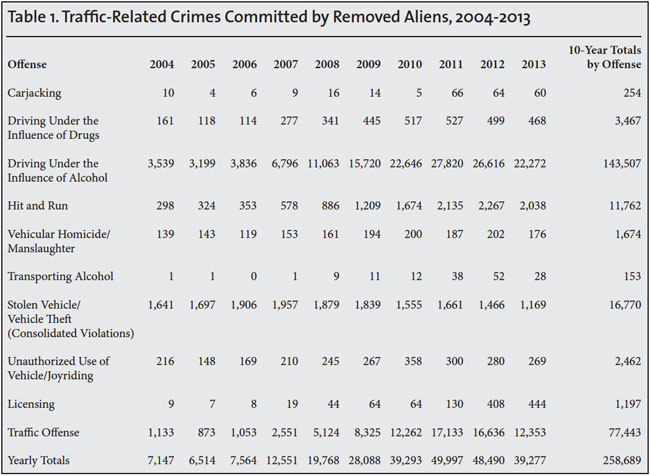| Topic: Drunk Drivers Given Immunity From Deportation? Executive Act | |
|---|---|
|
Executive Action to Benefit Alien Traffic Offenders
By Dan Cadman, Jessica Vaughan September 2014 Dan Cadman is a fellow and Jessica Vaughan is director of policy studies at the Center for Immigration Studies. [President Obama] Since almost the beginning, the Obama administration has distinguished itself from previous administrations by the number and expansive nature of the executive actions it has taken on immigration matters. The goal has been to undermine the enforcement of immigration law and limit the reach of ICE in order to protect a larger and larger number of illegal aliens from deportation. These actions typically are expressed as guidelines that sound benign, but which in practice also prevent the deportation of illegal aliens involved in crime, or whose behavior has endangered the public. One example is the Deferred Action for Childhood Arrivals (DACA) program. This program was sold to the public as deportation relief for young illegal aliens brought here by their parents, through no fault of their own, who have been in school, and have stayed out of trouble. While no doubt some DACA beneficiaries meet that description, the program operates in such a way as to also benefit less meritorious illegal aliens, including those who have committed crimes or other infractions, are involved in gangs, or who have caused other problems in their community.1 Additionally, in practice, a substantial number of the DACA recipients are not — and have not been — in school, belying the argument that the program was designed to permit them to obtain secondary education, college degrees, and become “productive members of society”. Many of these executive actions have been created out of whole cloth as a way of circumventing the legislative prerogatives of our Congress, thus rendering them both constitutionally and legally suspect. In our view, they have also harmed the national interest and public safety. The administration apparently remains committed to using executive action to obtain what it has been unable to achieve in the constitutionally prescribed manner, although the president has acknowledged the public anger and frustration over his handling over the recent border crisis involving the surge of tens of thousands of aliens, including women and children, in the Rio Grande Valley of Texas. However his acknowledgement has extended only to stating that he will wait until after the midterm elections before he takes further executive action — a decision that, however it is couched, reflects a disturbingly cold political calculation rather than one aimed to make peace with the American people and cease his overreach. There has been a great deal of public speculation as to the exact form any new executive action will take. One prominent organization with close ties to the Obama administration, the Migration Policy Institute (MPI), has produced an outline of the possible parameters of new executive actions entitled “Executive Action for Unauthorized Immigrants: Estimates of the Populations that Could Receive Relief”.2 This report distinguishes various methods by which the administration could extend, even further than it has already, its efforts to grant the effective equivalent of amnesty to aliens. Each of the methods carves out different portions (or aggregates) of the population of illegal aliens of the United States as potential recipients of executive action “relief” from deportation. Issuance of the report was also accompanied by a public “webinar”, during which an electronic slide show presentation was made.3 The slide show summarized the methods the administration might use to achieve additional “relief” from deportation. Our purpose in this report is to go beyond estimates of the number of illegal aliens who might benefit from executive action to explore the public safety ramifications of shielding these categories of aliens from deportation. We set out to answer the question: What are the characteristics of aliens who would likely be spared deportation as a result of the imposition of broader prosecutorial discretion guidelines? To accomplish this, we used a database of all ICE deportation cases from federal fiscal year 2004 through federal fiscal year 2013 (which we believe to identical to the dataset used by MPI analysts).4 We begin with an examination of the proposal to exempt from enforcement action those illegal aliens who have been “convicted exclusively of traffic crimes”. The presumed rationale for this proposal is that those illegal aliens whose only criminal conviction is for a “traffic crime” are not a threat to the public and therefore should not be subject to deportation. The implication is that ICE agents who seek the removal of illegal alien traffic offenders are overzealous and wasting scarce enforcement resources on cases that should be a low priority. According to MPI, which did not supply a definitive definition of “traffic offender”, applying executive action to this group of aliens for the years 2003 through 2013, would have protected 206,000 illegal aliens from removal. Our analysis (which does define traffic offenses), found that executive action would have protected 258,689 illegal aliens convicted of traffic offences from 2004 to 2013. Key Findings: An Obama administration executive action that protects from deportation those aliens convicted exclusively of traffic offenses potentially would shield thousands of dangerous drivers from deportation every year, including many convicted of drunk or drugged driving, judging by actual deportation records. Traffic crimes include a wide spectrum of offenses and crimes, ranging from drunk or drugged driving, to vehicular homicide, to joyriding, to improper lane changes, to driving without a license or insurance. Many of these are serious, involve fatalities, and put the public at risk. Proponents of such an executive action should be pressed to define exactly what offenses are meant or intended by the phrase. More than half (57 percent) of all aliens deported from 2004-2013 whose most serious conviction was a traffic-related crime were convicted of drunk or drugged driving. Other traffic-related criminal convictions of deported aliens included: carjacking, hit-and-run, vehicular homicide/manslaughter, transporting alcohol, vehicle theft, joyriding, and license offenses. The majority of all traffic-related crimes in the 10-year dataset were committed by adult male aliens (from late teens to mid 30s in age) who entered the country without inspection across the border, and therefore were almost certainly driving without a license and uninsured. Most aliens deported after convictions for traffic crimes had other aggravating circumstances that weighed on their case. More than one-half (55 percent) of aliens deported from 2004-2013 after traffic-related convictions had been deported from the country at least once before. In 2013, 70 percent of traffic offenders were prior-deportees. An even larger percentage (60 percent) of aliens convicted of lesser traffic offenses (a subset of traffic crimes) were prior deportees. |
|
|
|
|
|
What We Examined and Why
We begin our analysis of the proposed executive actions by looking at the proposal to grant relief to the population of deported aliens who, in the words of the MPI brief, were “[c]onvicted exclusively of traffic crimes”. MPI refers to this and other mechanisms involving forgiveness of offenses as “[r]e-focusing and strictly adhering to enforcement priorities”. We chose to focus on this proposed method of achieving executive action proponents suggest would benefit a relatively benign segment of the illegal alien population in the United States. We wanted to test the validity of that tacit assumption. Our examination encompassed 10 years of removals data, from 2004 through 2013. What Are Traffic Crimes? Use of the phrase “traffic crimes” is imprecise. This is an important point to make in the context of the removals datasets from which the key figures were initially derived and that led to the estimates of population size of affected aliens who would receive the benefits of deferred action. The authors of the MPI executive action brief did not explain what they intended by it. We interpret traffic crimes to mean crimes reasonably arising from, and on, the roadways. As such, in drawing from the 10 years of data, we examined the population of removed aliens who were convicted of the following offenses: Carjacking Driving under the influence of drugs Driving under the influence of alcohol Hit-and-run Vehicular homicide/manslaughter Transporting alcohol A consolidated category of stolen vehicle/vehicle theft offenses Unauthorized use of a vehicle/joyriding Traffic offenses such as driving without a license, speeding, etc. This latter category brings up an important point that must be made: One must not confuse traffic crimes with traffic offenses. The latter is a subset of traffic crimes, and reflects conduct that often (but not always) is dealt with by a summons (a “ticket” in everyday language) as opposed to a physical arrest by the police. A few additional notes are in order: The data almost certainly fail to accurately depict the universe of traffic-related crimes for the removed aliens due to the way they are captured in the database, or the way the offenses are charged by police. For example, an individual placed into a diversion program or granted probation or conditional release after being arrested for driving under the influence (DUI) who later violates the program, probation order, or conditional release, may be shown in the database as a violator of the program, order, or release rather than as a transparently traffic-related criminal. Similarly, an individual may be arrested and charged with DUI or hit-and-run, but fail to appear for court. When re-apprehended, it may be the failure to appear for court for which he is finally convicted, although the initial arrest was traffic-related. Likewise, the true extent of vehicular assaults may be underrepresented in the dataset by having been categorized simply as “assault” or “aggravated assault”, and therefore not amenable to extrapolation as traffic-related for purposes of our analysis. Even possession of counterfeit documents might have a traffic origin if the document in question is a forged driver’s license or vehicle registration in the possession of an alien pulled over by police. In conducting our research, we included stealing and theft of vehicles as traffic-related. Some may argue these are not traffic-related crimes, but we disagree. An individual stopped on the interstate in a stolen car or truck has committed a traffic offense. Conversely, however, we did not include robbery or larceny from vehicles or similar offenses in the dataset even though it is possible that some of these crimes arose from traffic stops. Because of the structure of the uniform crime codes described below, “unauthorized use of a vehicle/joyriding” is shown in the data as a category distinct from vehicle theft, and so we, too, have counted it separately. Finally, it is important to understand that the categories of crimes shown in the alien removals database are derived from the FBI’s Uniform Crime Reporting Handbook (UCR),5 which is the standard used by most police agencies throughout the United States. This provides for a certain level of statistical uniformity despite the bewildering shades of difference among state criminal statutes, and between states and the federal government, whose agencies also contribute to the UCR. However within the subset of data relating to aliens whose most serious crime is labeled a traffic offense, we believe it is likely that an unknown number of those crimes were more serious than the label would denote. An ICE or Border Patrol agent filling in a data screen may find it easier and less time consuming when opening up a scroll-down window to simply tag the data generically rather than search an extremely long list to find an equivalent (but more serious) crime descriptor based on UCR codes. This is particularly true given that, however these secondary fields are filled in, they will not change the way the individual is charged for purposes of removability, which is, after all, primary in the minds of the federal agents. 
|
|
|
|
|
|
What We Found
We found that a majority of traffic-related crimes tend to be committed by adult male aliens (from late teens to mid 30s in age) who entered the country without inspection and therefore were almost certainly driving without a license and uninsured. This poses a huge risk to other drivers on America’s roadways. We also know anecdotally from several cases that a number of those aliens whose most serious offense is listed as “driving under the influence” in fact injured or killed pedestrians or other drivers, but were for a variety of reasons not charged by police or prosecutors with the more serious offenses. In some egregious instances, the most serious charge levied was driving without a license, even when death or permanent maiming ensued. 6 A Snapshot by Crime Categories Carjacking. Carjackings constituted an extremely small percentage (.01 percent) of the total of 204,036 removed aliens who were convicted of traffic-related offenses in the years 2004-2013. But while the overall number of carjackings is small, they are extremely violent crimes and can sometimes endanger not only the driver, but also passengers, including small children who sometimes are in the vehicle during high-speed getaways, thus risking injury or death. Driving Under the Influence. The DUI-drugs and DUI-alcohol categories combined represent a staggering 57 percent of all traffic-related crimes over the 10-year period. Collectively, the DUI data should be a cause for alarm, given the high percentage of vehicle accidents in America today (especially those involving injury or death) that are drug or alcohol related. According to the National Highway and Traffic Safety Administration, drunk driving is the most frequently committed violent crime in America, killing 10,839 people last year, and costing the public billions of dollars annually. 7 It would be easy, but erroneous, to assume from the data that when the information indicates an alien’s most serious criminal conviction is for DUI, it represents a single offense. For example, an alien might be picked up repeatedly in the metropolitan Chicago area for DUI offenses, but never brought to the attention of federal authorities because the Cook County Jail has a policy of non-cooperation with ICE agents. Thus, it would not be until the alien was stopped for DUI in another jurisdiction that ICE might be notified of his arrest. What is more, a DUI conviction in the dataset can be misleading in that, as discussed earlier, it may mask the fact that injuries, maiming, or death attended the accident that the drunk or drugged alien driver caused. Hit-and-Run. Hit-and-run convictions represent almost 5 percent of traffic-related convictions among aliens removed during the years 2004-2013. Like DUI, hit-and-run crimes are amorphous: there is no way to know from the dataset how many of those hit-and-run vehicular accidents involved injury or death to others. And, like carjacking, hit-and-run can be a heinous offense because victims are often left to languish or die along the roadway because the driver flees rather than stopping to give aid. Thus the severity of the crime belies its small statistical weight. Vehicular Homicide/Manslaughter. These convictions constitute almost 1 percent of traffic-related convictions in the 10-year period analyzed, but of course each one of them represents at least one death, and some of them several. We also believe that this category is in fact an undercount. Some of the homicides and manslaughters shown in the dataset may have been on the highways, but unless they were specifically labeled as “vehicular” we excluded them from our tally. Transporting Alcohol. This offense represents a statistically insignificant proportion of the number of traffic-related crimes, but was included for completeness. Depending on the UCR encoding by the arresting officer, transporting alcohol might in fact range anywhere from a simple open-container violation to the much more serious crime of moving moonshine or untaxed whiskeys on the nation’s highways. It is also well to remember, however, that when one is violating the open-container laws, there is a high likelihood that one is, or will become, inebriated while driving. Stolen Vehicles/Vehicle Theft. This combined category represents 6.5 percent of the total of traffic-related crimes although, like homicide and manslaughter, there is a likely undercount because unless the theft was specifically described as vehicular it was excluded from our analysis. Note also that, although we included stealing and theft of vehicles as traffic-related crimes, we did not include robbery or larceny from vehicles in the dataset. Unauthorized Use of Vehicle/Joyriding. This category represents a mere 1 percent of the overall total of traffic-related crimes. It is important to understand, however, that a conviction for unauthorized use of a vehicle is quite frequently the result of a plea bargain down from the more serious felony of stealing a vehicle. Licensing. This category of crime consists primarily of offenses such as failure to register a vehicle, expired license plates, etc. Licensing-related traffic crimes constituted .46 percent of the total. There is also likely some overlap with the traffic offenses category, depending on how the arresting/citing police officer encoded the offense for UCR purposes in his report. Traffic Offenses. Traffic offenses consist of moving offenses such as speeding or failure to yield, as well as driver’s license violations (no license, expired license, etc.) and failure to maintain insurance coverage, etc. Not unexpectedly, these violations made up 30 percent of the entire volume of traffic-related crimes. As indicated above, there is likely some overlap with licensing violations in this category of offense. |
|
|
|
|
|
A Majority of Traffic Offenders Are Also Prior Deportees
We also examined aliens who had been removed who had traffic-related criminal convictions in the context of their prior adverse immigration histories. We believe that this is important and relevant, particularly in light of the assertion in the MPI brief that such offenders could be accommodated as recipients for executive action simply by “[r]e-focusing and strictly adhering to enforcement priorities”. This, of course, raised the question of whether or not federal agents were focusing on or adhering to enforcement priorities within the scope of this segment of the illegal alien population. Specifically, we looked at whether or not these individuals had been deported from the United States at least once prior to the traffic charges on which they were identified and taken into custody by immigration agents. Re-entry after deportation is a serious offense (a felony), and those who return illegally after deportation are a legitimate and important priority for enforcement. 
Prior Removals for All Categories of Traffic-Related Crimes. As is immediately evident from Table 2, the number and percentage of traffic crime violators who were, in fact, previous deportees was high. In other words, in a majority of cases, the traffic offenders that were selected for deportation had other aggravating circumstances that weighed on their cases. As can readily be seen, within the entire dataset of 10 years of removed aliens that we examined, 143,207 (55 percent) of the 258,689 individuals convicted of traffic-related offenses had been previously deported at least once, some several times. Under these circumstances, and contrary to what MPI suggests, it would be difficult to assert that federal immigration agents are not adhering to an important enforcement priority in tracking down and removing recidivist reentrants when they focus on aliens convicted of traffic-related crimes. Prior Removals for a Subset of Traffic-Related Crimes. In addition to examining the entire database of removed aliens who had been convicted for traffic-related crimes to find out who had been deported previously, we also examined a subset of such aliens based on what others might term “lesser offenses” (a term we dispute, but nonetheless believed was useful to examine for illustrative purposes in our analysis). This subset consisted only of removed aliens who had been convicted for the following categories of traffic-related crimes, which were described earlier in this Backgrounder: DUI (both drug- and alcohol-related offenses) Licensing violations Liquor transportation Traffic offenses Unauthorized use of a vehicle/joyriding 
Even focusing on so-called lesser offenses, we found that a significant number of these violators had been deported at least once prior to the removal the database captured. The percentage of “lesser offense” violators who had been deported previously was higher than for the universe of removed aliens included in the entire set of traffic-related crimes (60 percent vs. 55 percent). |
|
|
|
|
|
Conclusion
We believe that in the area of immigration policy, executive action under this presidency has reached the tipping point of unconstitutionality. However, even considered in the context put forward by advocates of such action, a very basic examination of the traffic-related crimes of deported aliens shows their severity. Many of the apparently insignificant offenses mask more serious offenses because they either are the result of charging (or plea bargaining) for lesser offenses, or simply don’t reflect the underlying reality that injuries or death were associated with the incident captured in a single data field of a massive government spreadsheet. This gets to the heart of the flaw in arguing that traffic offenders merit executive action because their crimes are minor. We conclude that there are profound policy and community safety reasons, in addition to constitutional constraints and rule-of-law arguments, not to undertake an executive action that spares “traffic offenders” from deportation. |
|
|
|
|
|
End Notes
1 See, for example, Rosemary Reynolds, “Judge Dismisses Immigration Case for Drive that Killed Two Girls”, FM News 101 KXL, August 19, 2014. 2 Randy Capps, Marc R. Rosenblum, James D. Bachmeier, “Executive Action for Unauthorized Immigrants: Estimates of the Populations that Could Receive Relief”, Migration Policy Institute, 2014. 3 The slide show presentation, of the same title as the MPI issue brief, can be found here. See, particularly, slides 10 and 11. 4 These data consist of detailed information relating to alien removals from the United States for a 10-year period, segregated by federal fiscal years from 2004 through 2013, including criminal offense data originally produced in response to a Freedom of Information Act request filed by a New York Times journalist. 5 Uniform Crime Reporting Handbook, FBI, 2004. 6 See, for instance, the Judicial Watch “Corruption Chronicles” blog of September 3, 2014, “Liberal Dem Blasts Obama Amnesty ‘Illegal Immigration is Not a Victimless Crime’”. See also Jessica Vaughan’s January 6, 2012, CIS blog, “Cook County Pressured to Reverse Sanctuary Policy”, and Dan Cadman’s March 24, 2014, CIS blog, “Public Advocacy, Victims, and Skewed Moral Compasses: U.S. government refuses to give U.S. citizen maimed by illegal alien information requested under FOIA”. 7 Mothers Against Drunk Driving, Fact Sheet on Drunk Driving in America, quoted in testimony of Jessica M. Vaughan before the House Judiciary Committee, hearing on “The Scott Gardner Act: Detention of Illegal Aliens Arrested for Drunk Driving”, March 7, 2012. |
|
|
|
|

|
|
|
|
|
|
ITS CALLED F@CK US BY OUR KING----
|
|
|
|
|
|
Been going on for a while now. In 2006 a friend of mine was side-swiped, forcing his suv into another car. Cop came to the 3 car wreck, and the driver at fault (an illegal immigrant) had an open vodka bottle, was so drunk he could barely stand up, had no license and no insurance. After a few minutes the immigrant was let go. He just left his wrecked car there and stumbled down the street. State had to dispose of the car (which was beyond totaled) According to the cop "No arrestable offense" was committed.
My friend's insurance paid the bill and attempted to sue the drunk driver, but he was nowhere to be found. I've got a few more stories of occurrences up here in Maine in the last few years. Not from illegals, but from recent immigrants as we had an influx of Somali immigrants years ago. Most of which are decent people trying to get jobs and be productive, but a few learned the new system and are exploiting the heck out of it. |
|
|
|
|
|
them dang ........ " dreaded 8letter word"
and their get out of jail free cards some churches are cover for the subversives too... |
|
|
|
|
|
Driven Florida lately? Our biggest concern used to be "snow birds"..... Not any more! Like our insurance rates weren't high enough already! You insurance rate doubles now for uninsured/under-insured coverage! |
|
|
|
|
|
not lately...
the birds of white feather flock together here in the land of sunshine... they are comin south now as I write. these birds are sort of different than what your used to though. \ these are of the "midwest breed"... from montana, dakotas on down... different work ethic and train of thought... we love em here we just call them winter texans... have several right here having work done... they want the best. about the insurance... mines 120.00 a year for 2 vehicles liability... not a misprint...it will probably go up though i hope not...am on another group policy its a drive any vehicle policy... 22.00 a month... I feel for you... you live in a very different kind of place... florida is probably not agricultural producer like it was 50 years ago... would appreciate your response on that.. had relatives there at one time they were the biggest producers in hernando co. all gone now. |
|
|
|
|
|
Edited by
detaildon
on
Sun 10/05/14 05:48 PM
|
|
|
Drunk Illegal Alien Who Killed Cop Qualified for Obama Amnesty
MAY 20, 2014 The drunk driver who killed a veteran Arizona police officer in a head-on freeway collision this month is an illegal immigrant with a criminal history that nevertheless qualified for amnesty under President Obamas broad plan. Why else would he be free to drive U.S. highways and work off the books as a gardener? The devastating story comes out of Phoenix, where an off-duty Mesa Police Officer (Brandon Mendoza) driving home from work, got slammed head-on. In the other car was Raul Silva Corona, an illegal alien from Chihuahua Mexico with a blood-alcohol level nearly three times the legal limit, according to various news reports. Officer Mendoza was only 32 years old and he served 13 years on the Mesa Police Department. Before crashing into him, Corona drove 35 miles along several Phoenix-area freeways in the wrong direction. Authorities received dozens of calls from drivers who saw the drunken man speeding the wrong way and they tried to pursue him, but couldn’t stop him. Both men died instantly and hundreds attended a vigil for the popular officer last week. Initial news reports did not mention the drunk drivers illegal status or criminal history, probably because its not politically correct. The media conveniently dismisses these crucial facts as irrelevant, though its a very important issue. Back in 1994 Corona pleaded guilty to criminal conspiracy in Adams County Colorado, according to court records obtained by the mainstream news outlet linked above. Evidently, it was part of a deal in which prosecutors dismissed the more serious charges of burglary, assault and leaving the scene of an accident. Under Obamas amnesty, tens of thousands of illegal aliens with criminal records more serious than Coronas are being released from U.S. custody. Just last week Judicial Watch reported that in 2013 Immigration and Customs Enforcement (ICE) freed 36,007 illegal immigrants convicted of violent and serious crimes from detention centers throughout the nation. The crimes include homicide, sexual assault, theft, kidnapping and alcohol-related driving convictions, according to the governments own records. The breathtaking documents were obtained by a nonpartisan research center dedicated to studying immigration issues. Last summer legislation crafted by the bipartisan Gang of Eight in the U.S. Senate would have granted amnesty to illegal aliens with drunk-driving, domestic violence, aggravated assault and child abuse convictions. Incredibly, groups that would normally be vocal on these sorts of issues remained silent. For example, the nations largest organization working to stop drunk driving and support victims of the violent crime Mothers Against Drunk Driving (MADD)refused to criticize the proposed law even though it would have rewarded those convicted of driving dunk. Through a spokeswoman, MADD said it doesnt get involved in immigration matters. Unbelievably, Corona would have qualified for Obama amnesty before committing the high-profile crime of killing a police officer. Family members have admitted in the media that the illegal alien gardener had been drinking hours before the crash and that they tried to stop him from driving. This guy was a real menace to society yet authorities let him roam freely after his encounter with the law years ago. In a touching farewell to Officer Mendoza published by a local newspaper, a Mesa park ranger writes that the fallen cop worked with troubled youth and helped clean up a crime-infested local park of drugs, alcohol and prostitutes. Brandon sadly unknown to you, you became that last line of defense with assisting your brothers who vowed as you did to Protect and Serve and gave the ultimate sacrifice in order that others may live. |
|
|
|
|
|
Illegal immigrant students bring ’21 Spanish dialects’ that teachers don’t understand
October 4, 2014 Tweet Kyle Olson Kyle Olson GAINESVILLE, Ga. – The placement of illegal immigrant students has wreaked havoc on schools across the country. immigrantsMany schools that have never had to deal with challenging situations related to immigrant students are now forced to do just that because of the federal government’s actions. The Statesboro Herald reports: Fifty-four Central American refugee students, some of whom cannot read or write, have been moved from their schools into a separate program at a Hall County public school, Lanier Charter Career Academy. The students, who crossed the border in precarious conditions to escape violence in their home countries, do not speak English. Their Spanish dialects are unfamiliar to the district’s Spanish teachers, and some have had little schooling. One student, a 14-year-old, has never been to school. Some others are able to read and write in their native language, but the dialect barrier has made it difficult to assess each student’s needs. “We decided to put them together at one place so we could provide the resources they needed,” Eloise Barron, the district’s assistant superintendent for teaching and learning, tells the paper. Cindy Blakely, the school’s principal, says, “For students who are fairly capable and not too far behind, our hope would be within a year or two that they are remediated enough to return to their high school, and also that they are able to live in the community and feel a part of the community.” Students are being taught about life in America, from the existence of public libraries to how the bus system works. In addition to what they went through before arriving in Georgia, the students are now in a strange country where they do not speak the language, far removed from the family members who continue to live under violent regimes in Central America, according to the paper. “There are 21 different Spanish dialects,” the district’s assistant superintendent says. The assistant superintendent tells the paper there is no special federal or state funding for the program her district is operating. |
|
|
|
|
|
DRUNKEN ILLEGAL ALIEN KILLS 6 PEOPLE IN MINUTE AND A HALF CAR CHASE!
By Dean James AMERICAS FREEDOM FIGHTERS- Well here we have it! Another ILLEGAL ALIEN ruining the lives of innocent people. What will it take to make these useless politicians understand that we do NOT want these animals in our country? ABC13 reports police attempted to pull over the driver of a Dodge Durango for a traffic violation. The officer lit up his lights and the illegal took off reaching speeds in excess of 100 MPH and a little over a mile later he ran a stop sign and crushed a Honda accord with 4 people inside. All 4 people inside the Honda were pronounced dead. 2 men in the Durango were also killed. The driver was identified as Juan Garcia Ahuezoteco and had an outstanding felony warrant for Driving While Intoxicated. Imagine that. |
|
|
|
|










